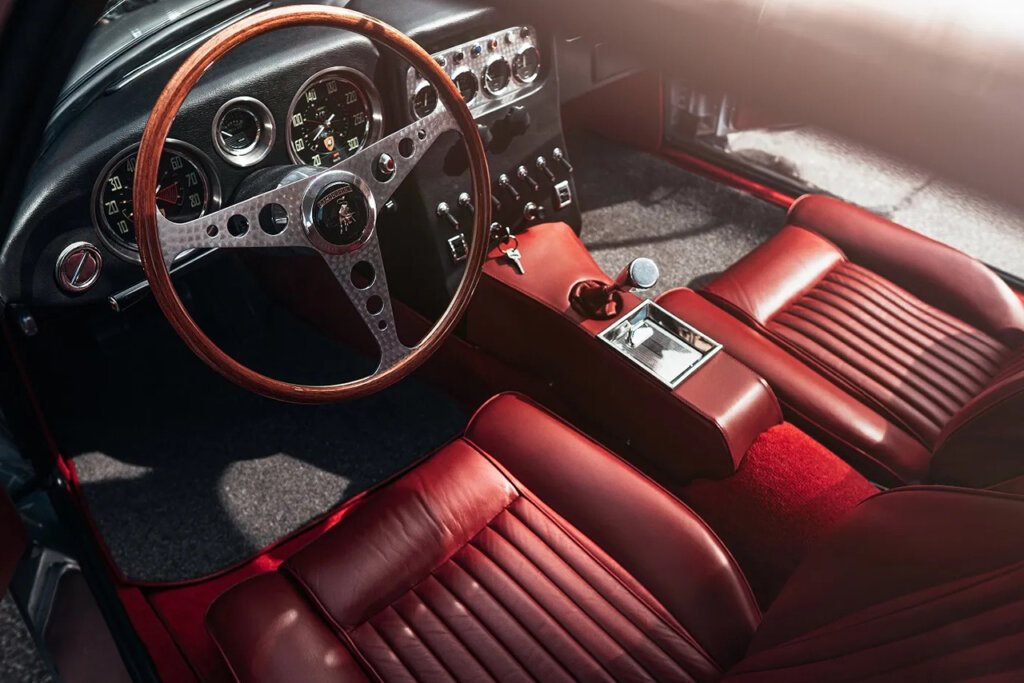
Source: Petrolicious
Produced between 1964 and 1966, the 350 GT was the brainchild of Ferruccio Lamborghini, an Italian industrialist who initially built tractors. Dissatisfied with his Ferrari’s reliability, Lamborghini set out to create a grand tourer that could rival Ferrari’s offerings but with more refinement. The result was the 350 GT, a car that blended performance, luxury, and style, defining Lamborghini’s ethos and laying the foundation for the brand’s future.

Source: Petrolicious
Ferruccio Lamborghini was known for his passion for fine engineering, and he recruited some of the best talent available to help create the car. One key figure in this development was Giotto Bizzarrini, a former Ferrari engineer, who was responsible for the design of the 350 GT’s engine. Carrozzeria Touring of Milan designed the sleek and elegant body. Produced in Sant’Agata Bolognese, Italy, the 350 GT was Lamborghini’s answer to the question of whether the newcomer could make a mark in the world of luxury grand tourers.

Source: Lamborghini
At the heart of the Lamborghini 350 GT was a 3.5-liter V12 engine designed by Bizzarrini. This powerplant was a masterpiece of engineering at the time, capable of producing 280 horsepower at 6,500 RPM and 240 lb-ft of torque at 4,500 RPM. What made this engine so impressive was its high-revving nature and smooth power delivery, offering a driving experience that felt both refined and exhilarating. The V12 was paired with a five-speed manual gearbox that allowed for precise gear changes and made the car feel agile and responsive, especially by the standards of the mid-1960s.

Source: Lamborghini
The engine had twin overhead camshafts, a feature that was still relatively rare in production cars at the time. Equipped with six twin-choke Weber 40 DCOE carburetors, the car could accelerate from 0 to 60 mph in around 6.8 seconds, which was a remarkable feat for the era. The top speed was an impressive 158 mph, making the 350 GT a true high-performance grand tourer.

Source: Lamborghini
Despite the car’s aggressive power figures, it was also designed with luxury in mind. The suspension was sophisticated, with an independent setup at both the front and rear, offering a smooth ride even at high speeds. The interior, too, was a hallmark of Italian craftsmanship, with leather upholstery, wooden dashboard details, and a well-finished cabin that ensured comfort and style.

Ferruccio Lamborghini’s decision to produce the 350 GT was largely motivated by his personal dissatisfaction with Ferrari. A car enthusiast, Lamborghini owned a Ferrari 250 GT, but he often found it unreliable and difficult to drive. After personally meeting with Enzo Ferrari to discuss the car’s shortcomings, Ferrari dismissed Lamborghini’s concerns, telling him to focus on tractors instead of sports cars. This moment of arrogance from Ferrari ignited Lamborghini’s desire to prove him wrong, ultimately leading to the birth of Lamborghini Automobili.

Source: Lamborghini
Lamborghini set out to build a car that addressed the issues he found in Ferrari’s cars, which were too harsh and compromised comfort in the pursuit of performance. His vision was to offer a luxury grand tourer with high performance but also refinement, comfort, and better handling at speed. The 350 GT was designed to be not just a fast car but a more livable one—a car that could cruise long distances in comfort while still offering high-speed thrills when desired.











